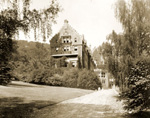EDWARD AND W. S. MAXWELL:

The partnership of Edward and W. S. Maxwell began in 1902. The combination of Edward's romantic style and William's classical training resulted in some unique designs. Nevertheless, some of the buildings, such as the Montreal Museum of Fine Arts and the Hosmer house, show the strong influence of William Maxwell, while others, such as the Ross house, are more characteristic of Edward's style.
EDWARD MAXWELL: (1867-1923)
Edward Maxwell was born in Montreal on December 31, 1867 and was the first son of Edward John Maxwell, a lumber merchant, and Johan MacBean. He attended Montreal High School until age 14, when he began working in the office of Alexander Francis Dunlop, a founding member and the first president of the Royal Architectural Institute of Canada.
In 1886 he moved to Boston, presumably to the office of H. H. Richardson. He is listed as a draughtsman in the Shepley, Rutan, and Coolidge office in 1888. Shepley, Rutan, and Coolidge had been Richardson's chief assistants at the time of his death and had formed a partnership to complete the unfinished projects. After 1889, Maxwell began supplementing his office training with some studies at the Boston Architectural Club.
He began to receive publicity when he was named to supervise the erection of the Board of Trade building in Montreal, designed by Shepley, Rutan and Coolidge. This assignment provided him both with the opportunity to gain acceptance to the newly-formed Quebec Association of Architects in 1891, and the publicity he needed to obtain a number of his own commissions. When the building was completed, he opened his own office in it and began work on several Montreal projects.
Some notable buildings designed by Edward Maxwell are the Henry Birks and Sons building on St. Catherine Street and the Vincent Meredith house. His work includes factories, churches, banks, railway stations and hotels throughout Canada.
In 1902 he entered into partnership with his brother, William S. Maxwell. In addition, some of his work was undertaken in association with George Cutler Shattuck, a former colleague from Boston, but this association did not continue after 1902. H was elected an Associate of the Royal Canadian Academy in 1903, and an Academician in 1908. When he died in 1923, the firm was in the midst of work on the Chateau Frontenac Hotel, Quebec City.
WILLIAM MAXWELL: (1874-1952)
William Sutherland Maxwell was born in Montreal, the second son of Edward John Maxwell and Johan MacBean. He attended Montreal High School until the age of 18, and in 1892 began to work in his brother's office in Montreal. In 1895, he went to Boston to work in the office of Winslow and Wetherel, a firm specializing in commercial and hotel architecture, and studied in the evenings at the Boston Architectural Club.
In 1898, he returned for 15 months to his brother's office and then went to Paris for a year to study as a special student at the Atelier Pascal, which was associated with the Ecole des Beaux-Arts. He returned to Canada in 1900, becoming a partner in his brother's firm in 1902. His skill and Beaux-Arts training added much to the firm, and were helpful in gaining commissions such as the Nurses' Home of the Royal Victoria Hospital and the Art Association of Montreal, which has been renamed the Montreal Museum of Fine Arts.
William Maxwell was a member of many professional associations. He was a Councillor of the Province of Quebec Association of Architects (P.Q.A.A.) (1908), an Associate of the Royal Canadian Academy (1909), President of the Arts Club (1913), President of the P.Q.A.A. and Academician of the Royal Canadian Academy (1914), Fellow of the Royal Institute of British Architects (1928), President of the Royal Architectural Institute of Canada (1935), and finally Vice-President of the Royal Canadian Adademy (1938).
He became strongly involved in the Baha'i faith and his house in Montreal became the first Baha'i home in Canada and a centre for religious activity in Canada and Latin America. He travelled to Haifa, Israel, a centre for the Baha'i faith, in 1939, remaining there throughout the Second World War, and finally returned to Canada in 1951. His house in Montreal was declared a Baha'i Shrine in 1952.
Sources:
Atherton, William Henry. Montreal from 1535-1914, Vol. 3. Montreal: S. J. Clarke, 1914, pp. 274-78.
Murray, Irena. Edward & W. S. Maxwell, Guide to the Archive. Montreal: Canadian Architecture Collection, McGill University, 1986.